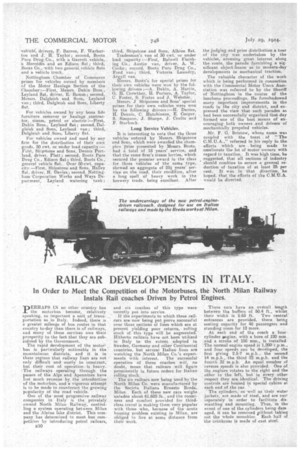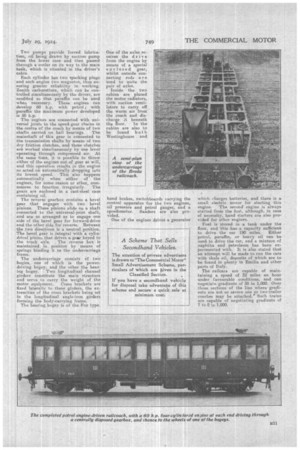RAILCAR DEVELOPMENTS IN ITALY.
Page 12

Page 13

If you've noticed an error in this article please click here to report it so we can fix it.
In Order to Meet the Competition of the Motorbuses, the North Milan Railway Instals Rail coaches Driven by Petrol Engines.
DERHAPS IN no other country has .1 the motorbus become, relatively speaking, 50 important a unit at transportation as in Italy. Indeed, there is a greater mileage of bus routes in that country to-day than there is of railways, and many of these services owe their prosperity to the fact that they are subsidized by the Government.
The rapid development of the motorbus is particularly noticeable in the mountainous districts, and it is in these regions that railway lines are not only difficult and costly to construct, but their cost of. operation is heavy. • The railways operating through the passes of the Alps and Apennines have lost much revenue by the introduction of the motorbus, and a vigorous attempt is to be made to counteract the growing popularity of the road vehicle.
One of the most progressive railway companies in Italy is the privately owned North Milan Railway, controlling a system operating between Milan and the Alpine lake district. This company has determined to meet bus competition by introducing petrol railcars,.
na0 and six coaches of this type were recently put into service.
If the experiments to which these railcars are now being put prove successful over those sections of lines which are at present yielding poor returns, rolling stock of this type will be augmented. Hitherto railcars have -not been utilized in Italy to the extent ,adopted in Sweden, Germany and other Continental countries, but several Italian lines are watching the North Milan Co.'s experi ments with interest. The successful operation of these coaches will, no doubt, mean that railcars . will figure prominently in future orders for Italian rolling stork. The six railcars now being used by the North Milan Co. were manufactured by the Societa Italiana Ernesto Breda, Milan. Each of these new cars weighs unladen about 61,600 lb., arid the roominess and comfort provided for thirdclass travel is making them very popular with those who, because of the acute housing problem existing in Milan, are obliged to live at some distance from their work. These cars have an overall length between the buffers of 50.4 ft., whiLst their width is 9.68 ft. Two central entrances are provided, there being seating capacity for 48 passengers and standing room for 12 more.
At each end of the coach a four. cylinderorigine, with a bore of 120 nun. and a stroke of 180 mm., is installed The normal engine speed is 1,200 r.p.m., and four speeds can be developed, the first giving 2.5-7 m.p.h., the second 14 m.p.h., the third 22 m.p.h. and the fourth 32 m.p.h. An equal number of • reverse speeds is also provided. One of ' the engines rotates to the right and the other to the left-, but in every other respect they are identical. The driving controls are housed in special cabins at each end of the car.
The cylinders, as well as their water jackets, are made of steel, and are cast separately in order to facilitate dismantling and mounting. Thus, in the event of one of the cylinders being dam aged, it can be removed without taking out the whole monoblnc. Each half of the crankcase is made of cast steel. • Twe pumps provide forced lubrication, oil being drawn by suction pump from the lower case and then passed through a cooler on its way to the main tank, which is situated in the driver's cabin.
Each cylinder has two sparking plugs and each engine two magnetos, thus ensuring greater reliability in working. Zenith carburetters, which can be controlled simultaneously by the driver, are modified so that paraffin can be used when necessary. These engines can develop 60 h.p. with petrol; with paraffin the maximum power developed is 50 h.p.
The engines are connected with universal joints to the speed-gear chains in the centre of the coach by means of two shafts carried an ball bearings. The mainshaft of this gear is connected to the transmission shafts by means of two dry friction clutches, and these clutches are worked simultaneously by one lever operating through compressed air. At the same time, it is possible to throw either of the engines out of gear at will, and this operation results in the engine so acted on automatically dropping into its lowest speed. This also happens automatically when either of tho. engines, for some reason or other, com mences to function irregularly. The gears are enclosed in a cast-steel case containing oil.
The reverse gearbox contains a bevel gear that engages with two bevel pinions. These pinions slide on a shaft connected to the universal-joint shaft, and are so arranged as to engage one side of the bevel gear for forward drive and the other side for reverse. Between the two directions is a neutral position. The bevel gear is integral with a cylindrical"pinion that drives a geer keyed to the truck axle. The reverse box is maintained in position by means of springs binding it ter the undercarriage frame.
The undercarriage Consists of two bogies, one of which is the power. driving bogey, and the other the bear
ing bogey. Two longitudinal channel girders constitute the main structure and serve to carry the weight of the motor equipment. Cross brackets are fixed laterally to these girders, the extremities of the cross brackets being set in the longitudinal angle-iron girders forming the body-carrying frame. The bearing bogey is of the Fox type.
One of the axles receives the drive from the engine by means of a special enclosed gear, whilst outside connecting rods are used to unite the pair of axles.
Inside the two cabins are placed the motor radiators, with suction ventilators to carry off the warm air from the coach and discharge it beneath the floor. In the cabins are also to he found both Westinghouse and band brakes, switchboards carrying the control apparatus for the two engines, oil pressure and petrol gauges, and a speedometer. Sanders are also provided.
One of the engines drives a generator which charges batteries, and there is a small electric motor for starting this engine. • The second engine is always started from the first, although, in case of necessity, hand starters are also provided for other engines.
Fuel is stored in a tank under the floor, and this has a capacity sufficient to drive the car 190 miles. Either petrol, paraffin, or heavy oil can he used to drive the car, and a mixture of naphtha and petroleum has been experimented with. It is also stated that an attempt will be made to run the cars with shale oil, deposits of which are to be found in plenty in Emilia and other parts of Italy.
• The railcars are capable of maintaining a speed of 32 miles an hour under favourable conditirms, and can negotiate.gradients of 30 in 1,000. Over those sections of the line where gradients are not so severe one or two trailer coaches may be attached,' Such trains are capable of negotiating gradients of 7 to Sin 1.000.






























